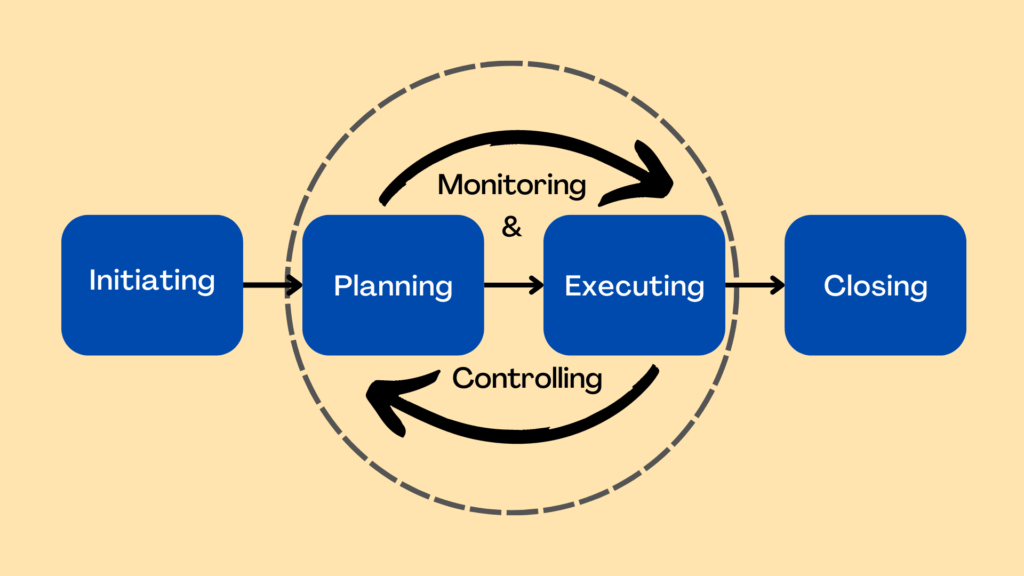The project management processes are broken down into five different process groups in the PMBOK Guide. These process groups have different processes belonging to different knowledge areas.
To succeed in project management, you must have a solid understanding of these five process groups. These groups organize the project processes mostly in the sequence as they are performed.
You will be able to understand the intricate structures of these process groups and their interconnections and interrelationships by consulting the PMBOK Guide. You can see how an output of one process is an input of another.
It is important to take note that the PMBOK Guide, sixth edition, contains this information. Due to a significant structural change, the PMI did not provide this information in the seventh edition of the PMBOK Guide.
Five Project Management Process Groups

The five process groups in project management are as follows:
- Initiating
- Planning
- Executing
- Monitoring & Controlling
- Closing
#1. Initiating
This is the first process group, and the project is initiated here. The group responsible for launching the process gives their approval for the project’s creation, names the project manager, determines the budget, and supplies resources, among other things.
During this stage, the project charter and stakeholder register are developed.
The team is guided by initiating process groups, and all team members will know the project’s goals. Throughout the entirety of the life cycle of the project, this helps to keep people engaged and informed. The Initiating Process Group ensures that the project objectives are aligned with the company’s strategic objectives.
Finding all relevant stakeholders is the next significant step in this procedure. A project is initiated to solve stakeholders’ problems, and its sole purpose is stakeholders’ satisfaction.
Therefore, the project manager must identify the project’s stakeholders as soon as the project charter is signed. These stakeholders will provide their requirements, and based on the requirement; the project manager will develop the plans, execute the project, and deliver the deliverables.
The project charter and the stakeholder register are the most important products from this process group.
#2. Planning
Planning is the basis of the project because if you fail to plan, you plan to fail.
In this process, the project manager collects the requirement and refine them, and based on these requirements; they will develop the project management plans. Project management involves various subsidiary plans such as scope management plans, cost management plans, risk management plans, communication management plans, procurement management plans, etc.
The plan may be iterative, or it may be detailed. If all project details are available, the project manager will develop a detailed plan; however, if not all details are available, they will adopt iterative planning.
In this stage, the project manager will develop performance baselines, which will include cost baseline, schedule baseline, and scope baseline, respectively. The project progress is measured against these baselines.
The planning phase is essential to the project’s success and provides the project team with a comprehensive road map they may follow to complete the project successfully.
To prevent disagreements and ambiguity in the later stages of the project, the project manager defines each team member’s roles, responsibilities, and tasks and assigns duties to the appropriate position.
The other project documents created in this process group include the following:
- Scope statement
- Work Breakdown Structure
- Project network diagram
- Risk register
- Issue logs
- Procurement documents
- Other documents and templates
The output of this process group includes a project management plan (cost management plan, communication management plan, risk management plan, procurement management plan, etc.) and other project documents (such as risk register, issue log, RFQ, purchase order, WBS, WBS dictionary, etc.).
Note that the planning process is always iterative, and project management can update or change the plan when any new requirements are added or deleted, any major risks occur, or the project is delayed and needs to bring back on track.
#3. Executing
The actionable work is carried out in the executing process group. The project will be carried out by the project management team, and the deliverable will be developed according to the requirements of the stakeholders. The project manager is responsible for coordinating the team to assist members in completing their assigned responsibilities and providing stakeholders with up-to-date information on the project’s status.
As they carry out the activities necessary to finish the project output, this process group uses up the majority of both the budget and the time.
The most important deliverables from this process group are the project document and any revisions to the plan.
#4. Monitoring & Controlling
Activities in the monitoring & controlling process group measure the project performance and ensure the project is on track; i.e., the project progress should be as per the performance baselines.
If there is any departure from the baselines, the project manager can make necessary adjustments by performing an integrated change management procedure and obtaining approval for the plans or baseline.
Monitoring and controlling are carried out throughout the project lifecycle until the project is concluded successfully. These activities are carried out concurrently with the carrying out of activities involving groups.
Take, for instance, the scenario in which the team is working on constructing a delivery while quality control personnel check the deliverable to ensure that it is accurate.
The most important deliverables from this process group are the project document and any revisions to the plan.
#5. Closing
Here the project completes. The client is provided with the deliverable, acceptance from the client is obtained, and the project is formally closed by the project manager.
The project manager is responsible for ensuring that all procurement contracts have been closed and all bills have been paid. They will be responsible for gathering the lessons learned, compiling them, and incorporating them into the organizational process assets.
Finally, they will celebrate the project’s ending and release the team and other resources.
Summary
All projects require these five project management process groups regardless of their type, size, and complexity. The project managers’ ability to complete the project with fewer obstacles will be directly correlated to their comprehension of these processes and interdependencies.
